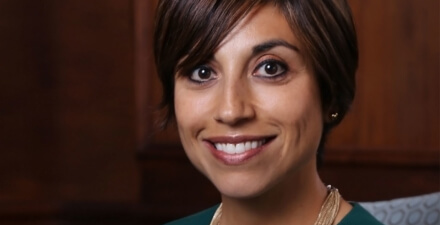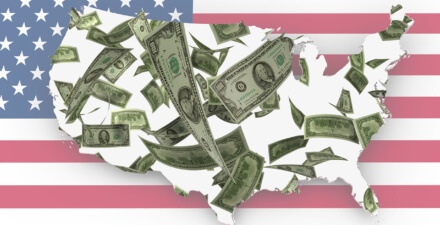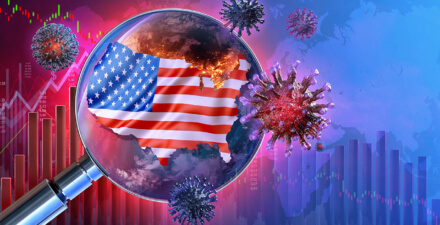Overview
“Equitable Growth in Conversation” is a recurring series where we talk with economists and other academics to help us better understand whether and how economic inequality affects economic growth and stability.
In this installment, Equitable Growth Policy Director Amanda Fischer talks with Mehrsa Baradaran, professor at University of California, Irvine School of Law and a member of the Board of Directors of the Washington Center for Equitable Growth. Baradaran is a leading scholar on financial services law and has developed a number of policies to address U.S. economic inequality and the racial wealth gap. Her most recent book, The Color of Money: Black Banks and the Racial Wealth Gap, explores the history behind the racial wealth gap and the reasons why it has persisted for more than 150 years. Baradaran focuses on the role of Black banks as a means by which to understand how Black communities build wealth in a segregated economy.
In an in-depth conversation about Baradaran’s research and its implications for public policymaking, she and Fischer discuss:
- Misunderstandings about the nature of financial inclusion
- Why crises help the wealthy and harm everyone else
- Small businesses and the coronavirus recession
- The myth of personal failures as a driver of poverty
- Why big businesses are held to different standards of responsibility
- The political decisions behind Federal Reserve monetary policymaking
- Fiscal policies to help the economic recovery be more equitable
Amanda Fischer: Thanks so much for chatting with me today.
Mehrsa Baradaran: Thank you for having me.
Misunderstandings about the nature of financial inclusion
Fischer: Mehrsa, as my first question for you, I’d like to discuss your scholarship and engagement with policymakers, which has focused on financial inclusion. To start this discussion, can you explain what the term means and the typology developed in your most recent research?
Baradaran: The reason I wrote the paper in the first place is because I think the term is often misused, and it is used as this plug into all sorts of different topics. So, when you hear financial inclusion a lot in the media, it’s based on some new fintech company or blockchain or some new app that is promising financial inclusion. If you’re older, like I am, you used to think about it as a microcredit or some sort of alternative system for the poor. And that, I think, is a misunderstanding of the system of financial inclusion.
What financial inclusion essentially means is there are people who are sort of excluded from the financial system. They don’t have access to credit or services. Mostly we’re talking about banking access, so people who are unbanked or underbanked, meaning they don’t have a bank account for some reason. And this is a problem mostly because it just costs a ton of money if you don’t have a bank account to do any sort of transaction. Anything you buy online, anytime you go to a store, checks, all of that stuff is provided for those of us who have bank accounts pretty seamlessly through apps and the internet, debit cards, credit cards, all of that stuff. If you don’t have a bank account, then you just have to pay a ton of money, up to perhaps 10 percent of your income just to cash checks and get prepaid debit cards and things like that.
It’s a problem of exclusion. But it’s also a problem because the banking sector is very much a public good. And I mean that in a couple ways. It’s a public good in that it’s like a utility that’s essential, such as electricity and light and water. But it’s also a public good in that it’s supported by the public. It’s not a private market. Banking is all about public utilities, such as deposit insurance and Federal Reserve payment systems and all of that stuff that makes access possible. And so, those who have bank accounts get this for free. It’s subsidized by the taxpayer and provided by the federal government.
But then, there are those who have to pay an extra toll. And this is sort of an unequal system. I wrote this paper to explain those dynamics and to explain why thinking about financial inclusion as a “fintech” thing or a blockchain thing misses the point, that the system is exclusionary. There are banks that aren’t in certain places because we’ve allowed them to merge. There are these dynamics in the banking sector that force banks—or, I guess, motivate banks—to go after high-profit customers and high-profit markets, and they just leave behind a whole bunch of communities. And that is a structural design issue. So, the paper is focused on that as a structural issue and solutions that focus on that problem as opposed to just add on products.
Why crises help the wealthy and harm everyone else
Fischer: I’m going to head right into the next question. Now that we have an understanding of financial inclusion and how definitions in the public sphere have been distorted, I want to understand some of the distributional aspects and how that plays out in a crisis. Whether it’s natural disasters, think Hurricanes Katrina or Sandy or Maria, or the great financial crisis from 10 years ago, these crises always hit society’s most marginalized people the hardest. I want to ask you, now that we are in this coronavirus crisis and its ensuing recession, how, in your view, have these gaps been exposed and magnified across the lines of low-wage, low-wealth households and wealthier households, and also across race and ethnicity?
Baradaran: There is an adage that I came back to in my book, The Color of Money: Black Banks and the Racial Wealth Gap, from a bunch of different people over time, specifically for the African American community, that says, “When Wall Street gets a cold, Harlem gets pneumonia.” I’ve heard it in a variety of different ways. But essentially, the message is that when there is any sort of economic crisis or any disaster, the Black community or any community on the margin get hits harder. And it’s not just that everyone suffers, and they suffer more, which is also true. But it’s also the case that these disasters can put those axes further apart.
In other words, if you had wealth beforehand, you can actually grow your wealth because of a disaster, and you do tend to. Wealth tends to protect you in a way, and it protects itself in a way, that actually multiplies your wealth. And if you didn’t have wealth, if you didn’t have that buffer, a crisis pushes you further down because you don’t have those protecting effects.
You did see this with the 2008 financial crisis. After the recovery from the financial crisis, really only the top 20 percent or 30 percent of society recovered. A ton of Black families lost their homes. They never got those back. Black communities lost 53 percent of their wealth during the financial crisis. I studied the same effects during the Great Depression, which hit Black communities much more acutely, took them much longer to recover then the White community, and part of that is because the New Deal made explicitly racist recovery decisions. But also, part of that is because it’s just harder to recover from blow after blow when you don’t have those buffers.
We’re seeing this again in this coronavirus situation. And it’s not just suffering economically. It is also suffering physically. You have more deaths, way more deaths proportionately in African American communities than White communities, and that is just a phenomenon of a compounding effect of all sorts of historic factors. And it’s a moment for us to step back and ask, “Why did this happen?” Obviously, the virus isn’t racist. It’s a colorblind effect that’s just going to hit everyone in its path.
So, the question is, who is in its path? And it tends to be people who have to work with other people and who are lower-wage essential workers. They are going to get hit. And they are disproportionately Black, and women, and also people who lack access to healthcare. All of these pre-existing confounding factors end up being correlated with income and wealth. So, that’s exactly what we saw happen.
The myth of personal failures as the driver of poverty
Fischer: I want to pivot to your recent piece in The Atlantic, where you wrote about both the policy and the cultural narratives around worthiness and individual choice, and how that can give policymakers cover to constrain the help available to the most marginalized households. But that same logic rarely applies to the wealthier households and to big business. Can you discuss how some of the tropes around personal responsibility are translating into unequal policy interventions in this moment?
Baradaran: Yes, this is a longstanding myth of poverty that we have, and it was a purposeful diversion created during the Reagan era specifically to cut welfare. The idea was based on the myth of all these welfare cheats, the welfare queen trope. But also, it was based on the dogma of self-reliance. If you want to avoid catastrophe, then you just have to save your money. And if you are poor or if you’re experiencing any sort of crisis, you could have prepared better for it. This is something that is embedded in our policy and has been for decades. And you see it come out in some of the conversations about welfare, where you have work requirements and drug-test requirements, and you can’t be a felon to receive any of the benefits.
And you saw that in the CARES Act, too. If you’re a felon at any time, like an ex-felon, at any time, you are not permitted to get Paycheck Protection Program loans if you own around 20 percent of a business. If you got out of prison for whatever crime you committed decades ago, and now you own a business along with other people, you are disqualified from PPP loans. That punitive type of policy is years in the making and is just so destructive to cohesion and actual real justice. The first version of the Republican bill had half of the stimulus funds available if you were below a certain income. Anyone making less than $50,000 a year only got $600 a month. It’s further punishing of people who have less that makes no sense, unless you understand that that’s the point. The point is to be punitive and to punish the poor and not to help.
And a lot of this has been racialized. Welfare was thoroughly racialized by President [Ronald] Reagan, President [Richard] Nixon to some extent, and then President [Bill] Clinton. Now, we have this conflation of poverty and Blackness that ends up also actually hurting the White poor, who are the majority of the poor. They also suffer disproportionately, it turns out, than other White people because they mostly live in red states, get less funding, and have fewer welfare programs. [Princeton University economist] Angus Deaton, in his book Deaths of Despair and the Future of Capitalism, documents how White poverty leads to earlier deaths because of the opiate crisis. All of those things are phenomena that can be linked exactly to this kind of policymaking.
Why big businesses are held to different standards of responsibility
Fischer: And we don’t see a similar prohibition on a large corporate recidivists getting their bond purchased by the Federal Reserve, like we see in the small business program with regard to those with felony convictions.
Baradaran: Yes, exactly, and I think you see that with even the “corporate savings.” Think Boeing not “saving their money” and pursuing stock buybacks instead. And so, coming up for a bailout where they could have had more “cash on reserve savings.” And we just don’t have that same sort of moral imagination, I think. And that was where I focused my Atlantic article, in that it’s really easy for us to judge people, even though we do it wrongly, but it’s hard for us to judge complex organizations. That’s really where the problems lie at this point. And I think we need to be better about maybe breaking that down and explaining it. First of all, don’t judge people, but also, here’s where the corporations screwed up. These were all the result of decisions made that were short-sighted.
The political decisions behind Federal Reserve monetary policymaking
Fischer: To your point about our support for large corporations in the CARES Act and otherwise, I think that there’s a perception that Fed interventions in the economy are just seen as bolstering “the market,” which is viewed as neutral. As if the market is natural law or the invisible hand. And the Fed is seen as this neutral arbiter that should not be used to advance policy goals, whether that’s addressing inequality or building out a faster payment system for individuals and families or being seen as an instrument to reduce climate risk. Can you talk about how the Fed being deployed to support “the market” is actually really a political choice? And what another way forward could look like?
Baradaran: This all happened around the same time as the stigmatization of the poor, and the moral overlay over the welfare program happened because of this neoliberal consensus about monetary policy. You can go back to Milton Friedman and monetarism, or [Fredrich] Hayek and other Austrians, and find a very explicit ideological movement that sort of disappeared decision-making about money out of the public forum and into some technocratic Fed.
This is not an anti-technocracy argument. I’m all about experts and technology, but it is these decisions of how much money supply and what kind of credit allocations happen where the Fed, in these situations, makes policy decisions, not technical decisions. And you saw that even during the financial crisis in 2008. The Fed’s quantitative easing and a lot of monetary policy ends up benefitting asset holders and explicitly making certain markets whole and other markets not whole.
The most simplistic example of this is the Fed not saving homeowners in 2008 and saving the asset holders of the mortgage-backed securities and the subprime debt instead. And rescuing the market was a lot easier to do because the Fed sits in New York City and Washington, D.C. and can push buttons to infuse money into the repo market, the commercial paper market, or money markets. It’s harder to send money to people. But these are policy decisions. These decisions make asset holders wealthier.
You’ve seen the disconnection now with the market recovery going on today. The stock market has recovered while something like 40 million people are unemployed. How can that be? Heather Boushey has done amazing work about what you measure. And if you’re measuring [Gross Domestic Product] through stock market indexes and how the S&P is doing, then that’s what we’re going to focus on and that is not a good indicator of the health of the economy and how it’s doing for the rest of us.
Fischer: Absolutely. You’ve touched on this a little bit, but as we flood the system with money, and we don’t necessarily think about distributional concerns—we think of those as a sideline to just getting the economy back on track—what could be the consequences of those decisions when we get on the other side of this recession? And what did the past global financial crisis teach us?
Baradaran: In simplistic terms, the rich get richer and the poor get poorer. Again, these are not equalizing crises. These pull the nodes further apart. If you had assets beforehand, a lot of the Fed actions are going to make you not only recover but even make money on some of these holdings. And if you didn’t have money, you’re not going to make any afterwards. This goes hand in hand with ideology, the way that we think about who get rescued and who gets help, who’s culpable and who’s not. And it has to do with the way that the Fed has been making policy outside of the democratic channels.
I know that this is not a great moment to be like, “Rah. Rah. Democracy.” We have big-time Electoral College problems. We had the rise of populism and nativism. Maybe you don’t want the American public being involved in monetary policy. But we do need to have some sort of debate about the distributional consequences of these things. And in the paper that I just released with the Roosevelt Institute, I liken it back to the gold and silver fiat currency debate during the Progressive era, where we had a gold-backed currency and that had certain consequences.
And one of the big consequences was that credit was constrained so people who were poorer didn’t get access to credit, and the market was constricted so that Wall Street benefitted. So, those who had gold made more money during the gold standard. And a lot of the populist progressive movement was based on a transition to silver currency, and that was seen as an expansion of credit, which it was. And it was a democratic decision. It was a decision to be made at the ballot box, which eventually took some time to do.
I think that’s the type of decision-making that the public can be engaged in today. What are the monetary policy outcomes, especially now that we’re actually far off gold and silver backing our currency? There’s no place you have to go to dig up money. You just kind of create it. That’s scary to people and that seems reckless, but money is a social understanding between a society as to what measure of value we’re going to use for goods. And the measure of value ends up having an effect on all sorts of market dynamics. Going back to what I was saying earlier about Milton Friedman and monetarism, those questions got pushed out of the realm of public discussion and into the realm of Federal Reserve monetary policy, where they have stayed ever since.
Fiscal policies to help the economic recovery be more equitable
Fischer: And it’s particularly important now, as the line between monetary and fiscal policy blurs when Congress punts on some decisionmaking by just appropriating a lot of money to the Fed to capitalize them as lender-of-last-resort. I think these governance questions are important as we think about the recovery. You and other scholars in the Equitable Growth network have been thinking about these issues for a long time and actually created a toolkit of ideas that would be ripe for this moment. Whether it’s postal banking or the 21st Century Homestead Act, can you talk about the policy solutions that your scholarship has focused on? And how that could be a road map for the way forward?
Baradaran: I focused on postal banking because that is a way to open up the banking sector to the unbanked and underbanked folks to achieve financial inclusion. I’ve talked about the Homestead Act as a way of doing a little bit to right the wrongs of the history of redlining and the racial wealth gap. And several other proposals that I’ve made along those lines were smaller public efforts. These are things that I’ve been working on for about 10 years, where they were obvious to me, and if you look at the structure of the system, these are big problems.
And you hate to be right about stuff like this, but the CARES Act just proves the postal banking point to such a fine degree that it’s almost made the case for me. If you have a $1,200 check trying to be given to each individual but with no infrastructure, then we have to run it through banks. Same with the Paycheck Protection Program loans. During the 2008 financial crisis, a lot of this stuff was exacerbated, and I think part of it is that we just misunderstand banking as a market activity and not as a public-sector activity. And a lot of the things that I learned about the way that the banking system works, I learned as a Wall Street attorney for the banking sector.
If you talk to people who understand banks, they understand that a lot of this stuff is public, but it’s people who have more idealized views of markets versus government that tend to be the sticklers about their given ideology, the free market, libertarianism, and all of that stuff. This is the kind of thing that I’ve been trying to push for, banking as a public-sector activity, and it has gained more traction over time. When I first started doing this in 2010, there weren’t many people who were public banking people. There weren’t people who were left progressive finance people outside of their own silo. You and Heather and others have been forming of a movement over time. So, that’s been good, I think.
Fischer: That is a great hopeful note to end it on. Mehrsa, thank you so much for this excellent discussion.
Related
In conversation with Trevon Logan
Coronavirus recession: How to get the U.S. economy back on track
Explore the Equitable Growth network of experts around the country and get answers to today's most pressing questions!






